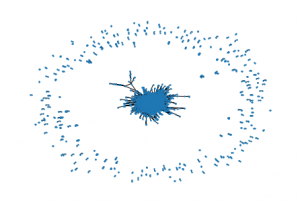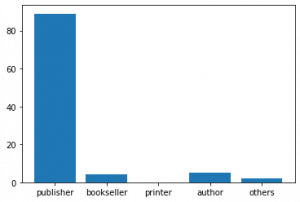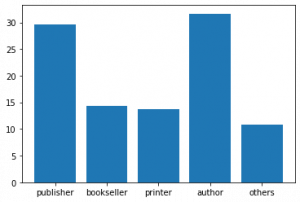Contents:
- Introduction
- Distant reading Shakespeare: Our First Case, the First Folio
- Our First Case, the First Folio (page 2)
- Our First Case, the First Folio (page 3)
- Grammatical context
- Case study: Rape of Lucrece
- Observations on the Shakespearean actor network
- Conclusion & References
Observations on the Shakespearean actor network
Each artist owes his popularity not only to himself, but also to other artists who referred to him in their works and thus permanently anchored him in culture. Shakespeare is no exception, so in the next part of our project we decided to check which Shakespeare reusers and editors who published Shakespeare reuses contributed the most to Shakespeare’s fame.
Materials, Method & Hypotheses
We did this using network analysis – a tool that allows us to examine the amount of influence between people (so-called actors) within a given community. The most influential actors were those who stood out in one of the three centrality measures: degree of centrality (the number of affiliations with other actors), eigenvector centrality (a measure that takes into account the degree of centrality of the actors with whom an actor is related) or betweenness centrality (a measure that determines whether an actor plays an important role as an intermediary between different areas of the network).
A dataset containing re-uses of Shakespeare’s texts up to 1810 was used for the analysis. We had two main hypotheses. Our first hypothesis was that a network built to reuse Shakespeare’s poetry would be dominated by actors other than the network of his plays. Second, we expected editors to play more central roles than authors in a total network.
Results
We were able to partially confirm the first hypothesis. The poem network was definitely different from the play network, mainly in size and density. The poem network consisted of only 110 nodes (actors) and 498 edges (connections between actors). In turn, in the case of play network, it was as much as 4009 nodes and 20187 edges. This size disproportion was also related to the difference in density, i.e. the ratio of the number of existing edges to the number of possible edges. The density is expressed on a scale from 0 to 1 and was 0.08 for the poem network and 0.002 for the play network. Thus, the poem network was as much as 40 times denser, and it was in this case that we could sooner expect actors to dominate the rest. The differences in the structure of the network are reflected in the charts below.

Poem network

Play network
The central actors turned out to be different for the two networks, as expected. This can be seen in the table below summarizing the actors with the highest scores for both networks and for each measure. However, it would be more careful to talk about partial confirmation of the first hypothesis, as the vast majority of them (all except John Milton) are publishers who played quite important roles in each network.
| Highest Degree | Highest Eigenvector | Highest Betweenness | |
| Poem network | J. Milton (40) | T. Longman (0.11) | T. Evans (0.22) |
| Play network | R. Baldwin (262) | R. Baldwin (0.17) | T. Cadell (0.05) |
Thus, we smoothly move to the second hypothesis, which has been completely confirmed. Indeed, pulishers played central roles in networks much more often than authors. It was already visible when comparing the main actors in the poem network and the play network. It is even more clearly visible in the comparison of charts presenting the percentage share of actors in a given role among all actors in the overall network (poems and plays together). The first graph was made with respect to the top 100 actors with the highest degree of centrality. Among them, the vast majority (89%) are publishers, while authors constitute only 5%. Meanwhile, among all actors publishers constituted only approx. 29%, and the percentage of authors was similar, or even slightly higher (approx. 32%).

Roles of 100 actors with the highest degree (in %)

Roles of all actors (in %)
Incidentally, it is worth noting that the roles were not assigned to the actors unequivocally. It happened that, for example, an actor who made some reuse as an author was also the publisher of another reuse. In such cases, the actor was assigned the role he played most often.
A tendency that emerged during the analysis was the predominance of relatively late reuses. Although the analysis covered cases from the end of the 16th century, most of the reuses were from the turn of the 18th and 19th centuries. The median of the year of publication was 1758 for poems and as much as 1780 for plays (as well as 1780 for the whole, which was dominated by plays). The question is, does this mean that Shakespeare only gained fame almost 200 years after his death? In our opinion, not necessarily. It should be taken into account that mankind produces more and more content over time. There is therefore a suspicion that this radical increase in the number of reuses was not specific to Shakespeare’s works, but applied to all literature and was associated with an increase in the number of authors, books, decrease in illiteracy and increase in readership. This is just a guess – whether it is true could be the subject of a separate analysis.
Reflections
So who made Shakespeare famous? As we might have expected from the beginning: there is no clear answer to this question. There are many indications that it is impossible to identify a single, most important person. With some generalization one could give the answer: publishers of the second half of the 18th century. This is probably not a particularly surprising answer. It seems quite likely that the authors collaborated more with publishers than with other authors, which places publishers at the center of the social network. A possible explanation of the dominance of the actors of the second half of the 18th century is given above.
Both the poem network and play network showed quite low density values, suggesting no strictly dominant actors in the center. Nevertheless, the poem network density was significantly higher, which may give some hope for a more unambiguous verdict. If we were to be tempted to single out one person within the poem network, it would be John Milton – an English poet of the 17th century. His presence at the center of the network may come as no surprise given that Brittanica, for example, calls him the most important English author after William Shakespeare. His high position may, however, be surprising because, contrary to statistical tendencies, he is neither a publisher nor did he create in the second half of the 18th century. So if the above analysis does not reveal much, pointing to the important role of John Milton, it at least highlights his greatness, showing that he played his role despite the statistically unfavorable role and the statistically unfavorable time of action.

John Milton (1608-1674)
